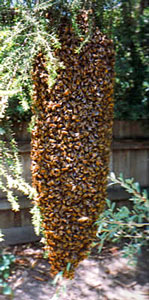Bees

Bees belong to the insect family which includes wasps, ants and sawflies. In Australia there are four main bee families. Many of these bees are solitary nesters, while others may share a nest. Others are fully social species. Although some bees sting, they are not generally considered to be pests as they play an important role in the Australian environment as key pollinators of many native plant species. bees
However, like the European Wasp, the Honey Bee is an introduced social insect. Worker bees visit flowers in search of pollen during the summer months, and may sting if handled or caught in clothing. They are particularly attracted to clover flowers, so it is wise to be cautious if walking through clover patches. Like wasps, Honey Bees will vigorously defend their nests.
Honey Bee stings are barbed and, when a person is stung, the sting (with venom gland attached) will stick in the skin and tear away from the bee. This injury kills the bee, but the venom gland continues to pump venom through the sting, so it should be removed as soon as possible. Do not squeeze it as this will force more venom into the wound. The sting is best removed by scraping it out with a fingernail.
Most Honey Bee stings cause intense local pain and swelling. However, if a victim is allergic to bee venom, a sting may cause more general symptoms. Most seriously, these can include difficulty breathing and collapse, and possibly even death. If a person is known to be allergic to bee venom, the sting should be removed and a pressure immobilization bandage should be immediately applied. Seek medical attention.
DO NOT attempt to eradicate swarming bees, unless you have the complete range of protective equipment and professional knowledge essential in the circumstances.
Contact Melbourne Pest Control for advice.

